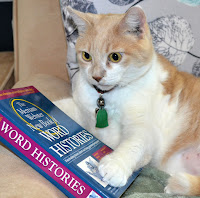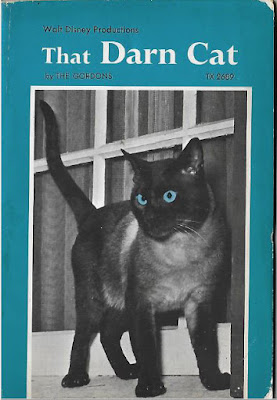 |
Puri Gagarin, Cosmocat, has his eyes on the Moon.
Photo courtesy Puri Gagarin. |
Friends, please help me welcome a very distinguished guest to the blog today. He’s a
Siberian who’s got his sights set on the Moon—and beyond. While you and I are
napping, he’s training in the Apawllo Program and preparing to leave the
Earth’s atmosphere. Who is this cat, I hear you asking? He’s Puri Gagarin,
Cosmocat. I can’t wait to learn all about him.
Hi, Puri! We’re so excited that you could join us today. Tell me, how did you get the excellent name Puri Gagarin?
Thank you for having me! My name originates from the fact
that I am a Siberian Forest Cat, so it was decided that I should have a Russian
name. When it came to actually selecting a Russian name, the fact that I wanted
to be a cosmocat really meant that the obvious choice would be to name me after
Yuri Gagarin, who was the first man in space and a fellow Russian. That being
said, there was concern that if I had the exact same name, then people would
become confused—one Yuri Gagarin would be the first man in space, while the
other would be the first feline on the Moon. Frankly, it would be a public
relations nightmare and could wreak havoc with the history books. To
distinguish the two of us, I adopted the first name “Puri,” which is an homage
to both Yuri and my feline roots.
It is a distinguished and fitting name, since you will be the first cat on the Moon. Have you always been interested in space?
I was about 12 weeks old when I joined the Apawllo Program
and moved to the Training Base, and I certainly wanted to become a cosmocat
long before that great day arrived. If I had to pin down a turning point, it
would be shortly after I opened my eyes for the first time. I remember looking
out a window and seeing the Moon shining in all its glory, and all I could
think about was how amazing it would be to chase toys across its surface.
Little did I know the technical challenges that would be involved, but that is
where the dream was born. Ever since that day, this goal has been basically all
I think about.
 |
Yuri Gagarin, first man in space, in a celebratory
parade in Warsaw, Poland, 1961.
|
It would be fun to chase toys on the Moon, wouldn’t it? I’m surprised no cat seems to have thought of this before. But space is a harsh environment, and your cosmocat training regimen must be intense. Can you give us an idea of a typical training day?
In a few words: “Rise and Grind.” Every day is intense, and
I only average about 16 hours of sleep a day because of these activities, so
mentally overcoming exhaustion is a huge component of my preparation.
Generally, I break my training up into three segments during a day, so that I
can recuperate with lengthy naps between sessions. Activities include chasing
toys (reflex training), watching out the window (observational training),
reading (important to train the mind), stretching (key for preventing training
injuries), and running around the house at full speed (cardio). At least once
per week I will also go on extended missions from the Training Base, as it
important to get out and explore.
Only 16 hours of sleep? That’s incredible. Tell me, we’ve seen you eyeing the International Space Station. Any plans for a visit there?
Absolutely! It is a great place to spend extended periods in
space conducting experiments. I also understand that they have mice on board,
so I am planning some specific experiments, such as mouse hunting techniques
and testing how far I can bat a mouse in zero gravity. That being said, I
promise that no mice will be harmed or eaten during these experiments. I will rather
engage them as co-experimenters and work collaboratively for the purposes of science.
It is time that we put our inter-species differences behind us and mend these
fences.
 |
Puri studies the International Space Station. He plans to conduct experiments with the help of some
mouse friends when it is his turn to join the crew.
Photo courtesy Puri Gagarin. |
Fascinating. Since you want to be the first cat on the Moon, do you have a “first pawstep on the Moon” speech prepared, like Neil Armstrong’s famous “One small step for man…”?
To be honest, this will really depend on what the Public
Relations team for the Apawllo Program determines. The program is bigger than
me, so I respect that I am part of the team and that whatever those first words
are will become an iconic part of feline history. That being said, I know that
the current view is to adapt Neil Armstrong’s words, primarily as a sign of
respect for the technology developed by humans that will make this feline
achievement possible. Most likely, the opening words will be “One small meow
for a cat, one giant roar for feline kind.”
 |
|
cosmocat to understand the mysteries of the universe, and an
observatory is the purrfect place to learn.
Photo courtesy of Puri Gagarin.
|
I’d love to hear that being broadcast from the Moon. What would be your ultimate space adventure?
 |
Puri checks out a transport option. In space, a cat must
be thoroughly familiar with his or her vehicle.
Photo courtesy Puri Gagarin.
|
In a word, it would be Mars. Going to the Moon is really a
starting point, but in the grand scheme of things the Moon is relatively close
to the Earth and it has already been visited by humans. Mars is the next big
milestone, as it will be the first time anyone sets paw or foot on another
planet. The challenge is that humans are already eyeing this prize, so the
Apawllo Program has some stiff competition from the likes of NASA. Ultimately,
I see this as the next big Space Race similar to the 1960s. Whether man or
feline gets there first is hard to predict, but I expect it will be a
photo-finish either way.
Does your
family support your career as a cosmocat?
They do and, frankly, I don’t think I could train properly
if I didn’t have their support. As an example, I haven’t been able to master
opening a can of wet food and there is no way that I could train so hard
without this nourishment. They are also excellent at piloting the Lunar Rover
for hours on end to take me to museums and observatories, which are an
important part of my educational regimen.
What does a cosmocat do to relax? Do you have any hobbies?
 |
Could Puri be the first earthling
on Mars?
By NASA and The Hubble Heritage Team
|
I think it is important to carve out some private time to relax with family and I definitely keep that a priority. Sometimes I spend my downtime just snuggled in bed with family watching a movie. On an ideal night, we will set up the telescope and spend a family evening under the stars.
That sounds nice. Family is so important, isn’t it? Anything else you’d like to add?
I would like to thank all of my supporters. Sometimes when I
am completely exhausted, those moments when I simply have nothing left in my
tank, then I will read through some of the comments I receive, and they inspire
me to push through and keep training. My supporters are a key element of the
Apawllo Program, and without them this mission simply would not be possible.
Thanks, Puri. It was
great meeting you and learning about what it’s like to be a cosmocat!
Thank you so much for having me
today!
 Words with Webster
Words with Webster

 And now it’s time for Friendly
Fill-Ins, from 15andmeowing and McGuffy’s Reader. They are a fun way to learn a little bit about the authors of
the blogs you read. The first two questions are from Ellen of 15andmeowing, and
the next two are from Annie of McGuffy’s Reader. Real Cat Paisley provided all
the answers this week.
And now it’s time for Friendly
Fill-Ins, from 15andmeowing and McGuffy’s Reader. They are a fun way to learn a little bit about the authors of
the blogs you read. The first two questions are from Ellen of 15andmeowing, and
the next two are from Annie of McGuffy’s Reader. Real Cat Paisley provided all
the answers this week.









































